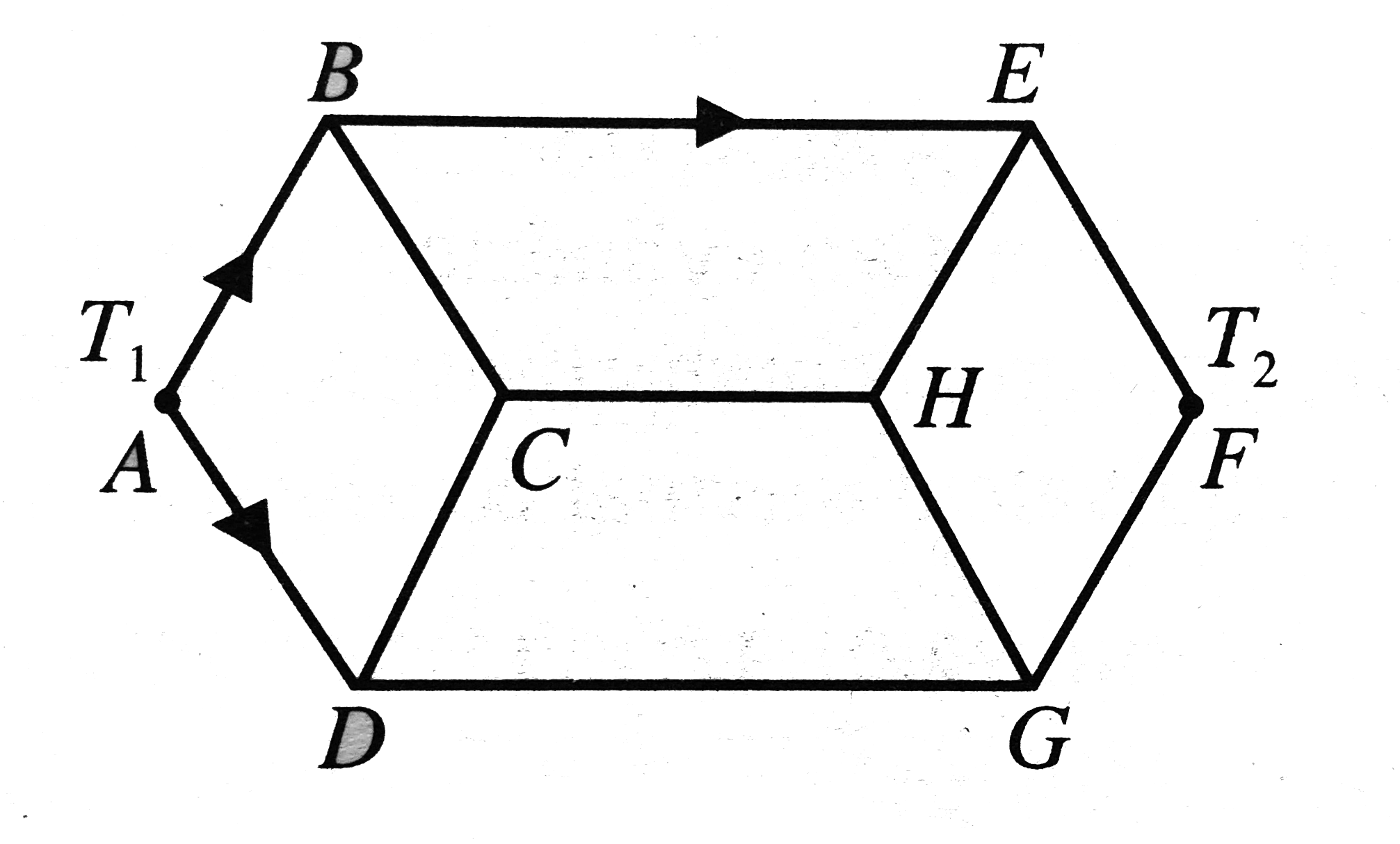A rof of length l with thermally insulated lateral surface consists of material whose heat conductivity coefficient varies with temperature as x=α/T, where α is a constant. The ends of the rod are kept at temperatures T1 and T2. Find the function T(x), where x is the distance from the end whose temperature is T1, and the heat flow density.
The correct Answer is:T(x)=T1(T2T1)x/1;H=αlIn(T2T1)
Step by step video, text & image solution for A rof of length l with thermally insulated lateral surface consists of material whose heat conductivity coefficient varies with temperature as x = alpha//T, where alpha is a constant. The ends of the rod are kept at temperatures T_1 and T_2. Find the function T (x), where x is the distance from the end whose temperature is T_1, and the heat flow density. by Physics experts to help you in doubts & scoring excellent marks in Class 12 exams.
Updated on:21/07/2023Topper's Solved these Questions
- HEAT AND TEMPERATUREBook:FIITJEEChapter:HEAT AND TEMPERATUREExercise:ASSIGNMENT PROBLEMS (OBJECTIVE) (LEVEL-I)
Explore 50 Videos
- HEAT AND TEMPERATUREBook:FIITJEEChapter:HEAT AND TEMPERATUREExercise:ASSIGNMENT PROBLEMS (OBJECTIVE) (LEVEL-I) (ASSERTION AND REASON)
Explore 2 Videos
- HEAT AND TEMPERATUREBook:FIITJEEChapter:HEAT AND TEMPERATUREExercise:ASSIGNMENT PROBLEMS (SUBJECTIVE) (level-1) (TRUE OR FALSE QUESTIONS)
Explore 6 Videos
- GRAVITATIONBook:FIITJEEChapter:GRAVITATIONExercise:Numerical based Question
Explore 2 Videos
- KINEMATICSBook:FIITJEEChapter:KINEMATICSExercise:NUMERICAL BASED QUESTIONS DECIMAL TYPE
Explore 5 Videos
Similar Questions
The gas law PV=constant is true for
View SolutionStatement 1: When heat is given to a system then temperature of the system must increase.
Statement II: A warmer body must have more internal energy in comparison to another colder body.
View SolutionIsothermal and adiabatic process are identical.
View SolutionA particle is projected radially outwards from the surface of a planet with an initial speed of 4.0km/s. Maximum height attained by the particle is h=900km. Find the radius of the planet taking g=10m/s2.
View SolutionTwo highways are perpendicular to each other : imagine them to be along the x-axis and the y-axis, respectively. At the instant t=0, a police car P is at a distance d= 400m from the intersection and moving at speed of 80km/h towards it along the x-axis. Motorist M is at a distance of 600m from the intersection and moving towards it at a speed of 60km/h along the y-axis . The minimum distance between the cars is
View SolutionOne end of a thermally insulated rod is kept at a temperature T_1 and the other at T_2 . The rod is composed of two sections of length l_1 and l_2 and thermal conductivities K_1 and K_2 respectively. The temperature at the interface of the two section is
View SolutionA rod of length l with thermally insulated lateral surface consists of material whose heat conductivity coefficient varies with temperature as k=a/T, where a is a constant. The ends of the rod are kept at temperatures T1andT2. Find the function T(x), where x is the distance from the end whose temperature is T1.
View SolutionA rod of length l and cross sectional area A has a variable conductivity given by K=alphaT , where alpha is a positive constant T is temperatures in Kelvin. Two ends of the rod are maintained at temperatures T_1 and T_2(T_1gtT_2) . Heat current flowing through the rod will be
View Solution
Eleven identical rods are arranged as shown in Fig. Each rod has length l, cross sectional area A and thermal conductivity of material L. Ends A and F are maintained at temperatures T1 and T2(<T1), respectively. If lateral surface of each rod is thermally insulated, the rate of heat transfer (dQdt) in each rod is
View SolutionOne end of a rod, enclosed in a thermally insulating sheath, is kept at a temperature T1 while the other, at T2. The rod is composed of two sections whose lengths are l1 and 12 and heat conductivity coefficients x1 and x2. Find the temperature of the interface.
View SolutionA rof of length l with thermally insulated lateral surface consists of material whose heat conductivity coefficient varies with temperature as x = alpha//T , where alpha is a constant. The ends of the rod are kept at temperatures T_1 and T_2 . Find the function T (x) , where x is the distance from the end whose temperature is T_1 , and the heat flow density.
View SolutionA rod of length L with sides fully insulated is made of a material whose thermal conductivity K varies with temperature as K=αT where α is constant. The ends of rod are at temperature T1 and T2(T2>T1) Find the rate of heat flow per unit area of rod .
View SolutionA rod of length l with thermally insulated lateral surface is made of a matrical whose thermal conductivity varies as K =C//T where C is a constant The ends are kept at temperature T_(1) and T_(2) The temperature at a distance x from the first end where the temperature is T_(1), T =T_(1)((T_(2))/(T_(1)))^(nx//2l) Find the value of n? .
View SolutionA rod of length l with thermally insulated lateral surface is made of a material whose thermal conductivity varies as K=sc/T where c is a constant. The ends are kept at temperatures T1 and T2. Find the temperature at a distance x from te first end where the temperature is T1 and the heat flow density.
View SolutionA rod of lengh l with thermally insulated lateral surface consists of material whose heat conductivity coefficient varies with temperature as x=α/T, where α is a constant. The end of the rod are kept at temperature T1 and T2.
Find the function T(x), where x is the distance from the end whose temperature is T
View SolutionA rod of lengh l with thermally insulated lateral surface consists of material whose heat conductivity coefficient varies with temperature as x=alpha//T , where alpha is a constant. The end of the rod are kept at temperature T_(1) and T_(2) . Find the heat flow density.
View Solution
